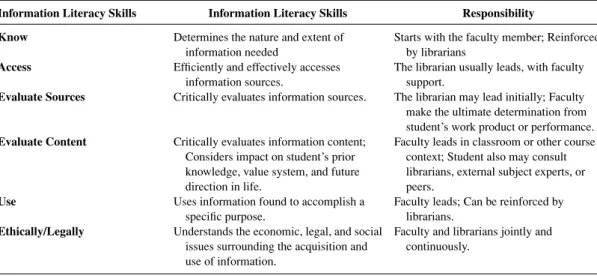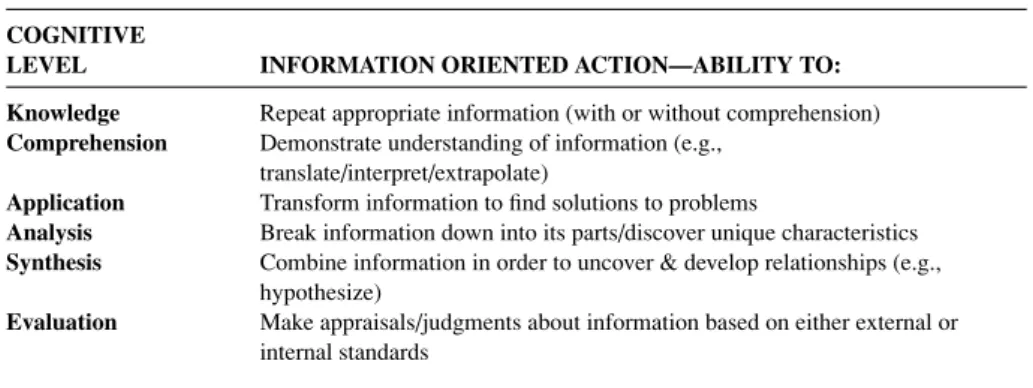An Illustration in Process: Recommended Sequence for Bibliographic and Information Literacy for an Interdisciplinary Program i These goals are stated as the first step in the development of disciplinary skills in information literacy for teacher preparation majors (Chapter 5). An emphasis on inquiry inherent in the active process of information seeking, a process that is often not linear and often interdisciplinary, is at the heart of the student's information literacy.
Assessing Information Literacy Among Undergraduate Students: A Discussion of the University of California-Berkeley Assessment Literature and Experience.” College. There must be shared responsibility for teaching and assessing information literacy skills to ensure the necessary reinforcement. American Library Association (ALA), Association of College and Research Libraries (ACRL), STS Task Force on Information Literacy for Science and Technology (2006). Information Literacy Standards for Science and Engineering/Technology.
During the introductory-level instructional session, students are introduced to the film information skills relevant to the focus of their curriculum. The librarian will provide the film professor with the mutually determined assessment of the student's bibliographic and information literacy skills for consideration in the senior project's final grade. The conclusion of this process was to develop information literacy objectives for the teacher preparation program.
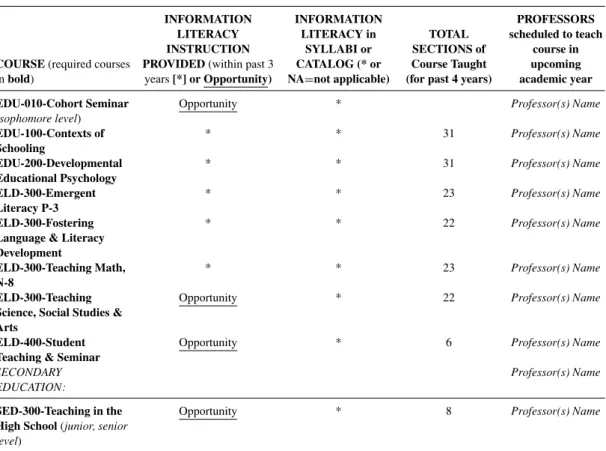
Education and Organizational Standards
With this intention, there will be a coordinated effort between the librarians and the Education Resource Center staff to promote student resource use. It is also recommended that the students on the teacher preparation course develop a contact with the librarian in the school library's media center during their internship. The process of developing the proposal began with a curriculum map for the major (see Chapter 1), an identification of the department's assessment objectives, and a review of the course syllabus.
Next, state and national information literacy standards developed for the K-12 curriculum were identified and reviewed.
Information Literacy Standards for the K-12 Curriculum
Understands Content: Principle #1: "The teacher understands the central concepts, research tools, and structures of the discipline(s) he/she teaches and can create learning experiences that make these aspects of the subject matter relevant to students." Understands Development: Principle #2: "The teacher understands how children learn and develop, and can provide learning opportunities that support their intellectual, social, and personal development." Understands Difference: Principle #3: "The teacher understands how students differ in their approaches to learning and creates learning opportunities that are tailored to different students."
Designs Instructional Strategies: Principle #4: "The teacher understands and uses a variety of instructional strategies to encourage the development of critical thinking, problem-solving, and performance skills in students.". Leads and Motivates: Principle #5: "The teacher uses an understanding of individual and group motivation and behavior to create a learning environment that encourages positive social interaction, active involvement in learning, and self-motivation.". Communicates: Principle #6: "The teacher uses knowledge of effective verbal, nonverbal, and media communication techniques to promote active inquiry, collaboration, and supportive interaction in the classroom.".
Plan and integrate: Principle #7: "The teacher plans instruction based on knowledge of subject matter, students, the community, and curriculum goals." Evaluate: Principle #8: "The teacher understands and uses formal and informal assessment strategies to evaluate and ensure the ongoing intellectual, social and physical development of the learner." Reflection on practice: Principle #9: “The teacher is a reflective practitioner who constantly evaluates the effects of his/her choices and actions on others (students, parents and other professionals in the learning community) and who actively seeks opportunities to professionally growth. .”.
Participate in the professional community: Principle #10: "The teacher cultivates relationships with school colleagues, parents, and agencies in the larger community to support student learning and well-being." [consider school library media specialists and public librarians.].
The Library’s Support for the Teacher Preparation Assessment Goals
After reviewing the INTASC standards, it was decided that the library will concentrate on supporting the INTASC principles (see Figure 5.1) identified in bold.
Relating the Information Literacy Standards to the Education Standards
Developing Bibliographic and Information Literacy Objectives for the Teacher Preparation Program
Developing the Skill Sequence
Related to INTASC Principle #1,2) STANDARD 5: The student who is an independent learner is information literate and appreciates literature and other creative expressions of information. Objective B: Students will understand the production of knowledge for curricular resources (print and electronic) to support students in grades P-12. Objective D: Students will use and collaborate with the school library media specialist as a teacher and resource person (narrator, literature consultant, reference consultant, research consultant, selector/purchaser, technology consultant).
Objective E: Students identify primary, secondary, and tertiary literature and effectively use appropriate resources (both print and electronic) to support and enhance the classroom learning experience, resource-based learning, and recreational reading of students in grades P-12. Objective G: Students evaluate the value of a resource by considering its reliability, validity, accuracy, authority, timeliness, point of view, or bias. Graduate skill development throughout the range from cognitive knowledge levels to assessment; introduced at the introductory level; supports INTASC Principle relates to AASL/AECT standard relates to ACRL standard #5].
Graduated skill development from cognitive levels from analysis to synthesis to evaluation; introduced at the junior level; supports INTASC Principle #2, 11; relates to AASL/AECT Standard. Cognitive level: application; introduced at the introductory level; supports INTASC Principle #1; relates to AASL/AECT standards relates to ACRL Standard #5]. Supervisors from [the university] observe the student teachers at work, confer with the cooperating teachers and student teachers, and evaluate the growth of the student teachers during the internship period.
Information skills currently taught: NA (possibility) Strengthening of required skills: A, B, C, D, E, F, G (level of evaluation), H (level of evaluation), I Teaching improvements needed: NA (possibility).

Additional Preparations for Introducing our Proposal
With this information we were in a position to meet with the chairman of the Teacher Preparation Department to discuss our proposal. Standard One: The information literate student determines the nature and scope of the information needed. Standard Five: The information literate student understands many of the economic, legal and social issues surrounding the use of information and accesses and uses information ethically and legally.
The location of the workshops will rotate between the library and the education's resource center as needed, so that the students are exposed to relevant sources in both places. The purpose of the additional presence of information literacy in the cohort seminar (or workshop) will be to provide consistent instruction of the recommended goals for this level, while allowing all students time to practice their skills on multiple occasions and for multiple assignments. This will be a coordinated effort between the librarians and staff at the Education Resource Center in collaboration with the school media center librarian at the location of the student's field placement.
Language Arts: National Council of Teachers of English (NCTE): The list of standards for the English language (http://www.ncte.org/about/over/standards). Mathematics: National Council of Teachers of Mathematics: Principles and Standards for School Mathematics (http://standards.nctm.org). Social Studies: National Council for the Social Studies (NCSS) Standards and Position Statements (http://www.ncss.org/standards).
Science: National Standards for Science Education (http://books.nap.edu/html/nses/overview.html) Arts: National Standards for Arts Education (developed by the Consortium of National Associations for Arts Education through a grant administered by the National Association for Music education) (http://artsedge.Kennedy-center.org/teach/standards.cfm. Foreign Language: Standards for Foreign Language Learning (http://www.act.org/i4 a/pages/index) .. cfm ?pageid=3324) School Counseling: American School Counselor Association (ASCA) National Standards for School Counseling Programs.
Council for Exceptional Children (http://www.cec.sped.org/ab/student.htm) IRA/NAEYC (http://www.naeyc.org). In addition, students preparing to become teachers should be aware of the reference resources, periodicals, and academic databases available to students in their P-12 libraries.
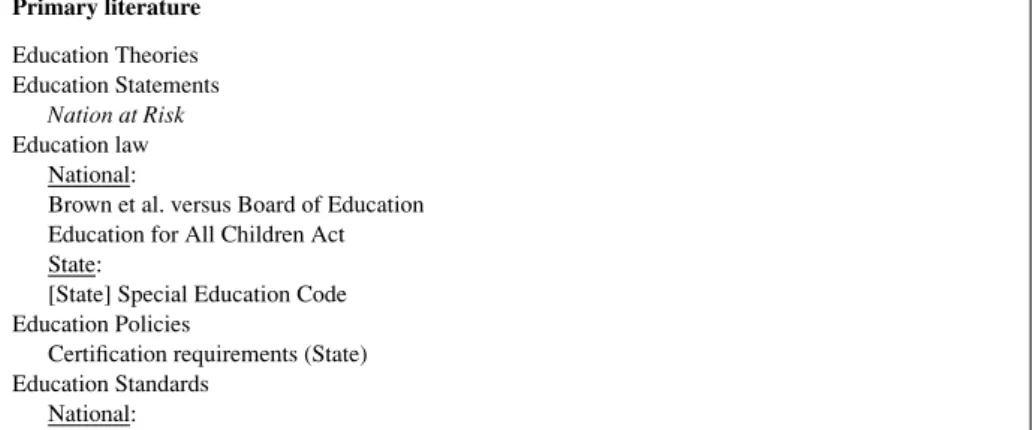
Shared Responsibility for Assessment
These textbooks are examples of shared responsibility for teaching information skills. This abbreviated model describes the core courses, the current information competencies covered by each, and the information competencies recommended (required) for the level of the sequence. In this way, we were able to identify the information literacy courses (see Figure 6.3) that would reach students on the majority of tracks.
The information literacy measures considered each of the standards and best practices listed above in addition to the content taught in the core business courses. Successful completion of the Freshman seminar requires that the students complete the information literacy exercises satisfactorily. The content of the curriculum for the development of first-year information competence will include the following elements (see figure 7.3).
The results of the research plans will inform librarians about improvements needed in the teaching of business information literacy skills. In addition, each major is tested for specific information literacy skills required of the major. The choice of company determines the level of creativity required for the research process.
Course description: "The principles of successful retailing are analyzed within the strategic planning process. Objective C: Students will be able to compare/contrast information from multiple sources in order to ensure the accuracy of the information used. The following is a pilot assessment of information literacy skills for the introductory workshop, revealing several areas that required strengthening in the teaching and learning process.
For example, whether the student's use of the "free web" was appropriate for a sociology assignment. In the summary of data describing the level of students' knowledge (Figure 10.6), the rows are organized by. This average score becomes the identification of the proficiency level in the summation for each information literacy objective.
Some of the objectives were not taught in the library instruction session but will be in the future (ie, Objective I. A).
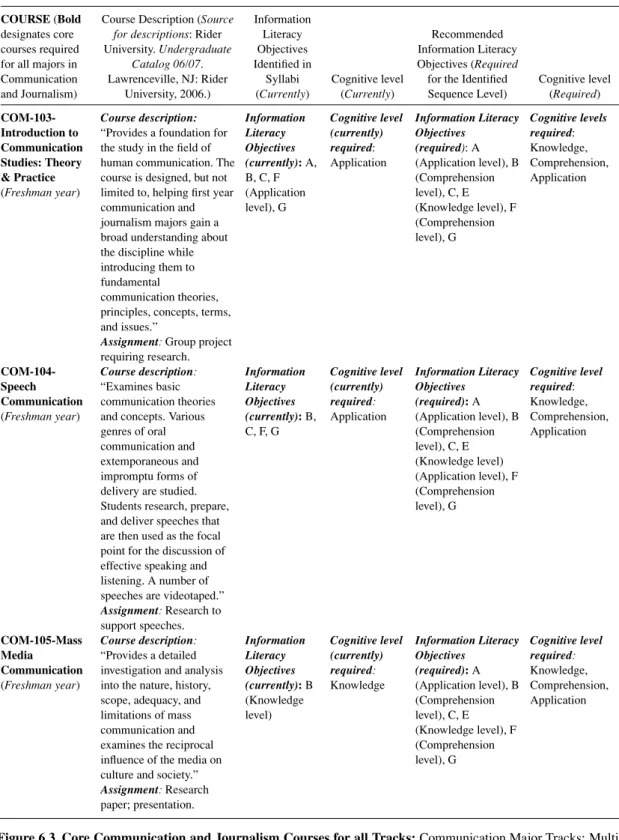
Index
Organization of proposals, 7 Outcome assessment, defined, xi Performance measure, xii Physical object, 15 Political players, 1, 33-34 Portfolio, 75.
